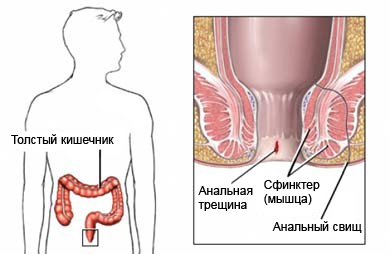Anal fissure
Description of anal fissure
Anal fissure – painful rupture of the anal canal. Anal canal – opening, through which stool excreted from the body. The gap typically occurs only within the bore.

Causes anal fissure
Big, dry, or hard stool can tear the anus. Frequent diarrhea or irritation of the anus and rectum can also cause cracks.
Risk factors
Risk factors for anal fissure are:
- Constipation;
- Tension during defecation;
- Previous anal surgery, which could scratch and reduce the elasticity of the fabric;
- Chronic diarrhea.
Symptoms of anal fissure
Symptoms of an anal fissure are similar to those of other siptomy, more serious diseases. Therefore, the appearance of the following symptoms should seek medical advice:
- Pain during and after a bowel movement;
- Burning sensation during a bowel movement;
- Bleeding during defecation;
- Bright red blood on toilet paper or in the toilet;
- Itching of the anus;
- A small amount of mucus in the stool.
Diagnosis of anal fissure
Carry out the analysis of the anal region, includes the following:
- The doctor pushes the buttocks, anus is visible from the outside, and it allows us to see the presence of cracks;
- If the crack is stored for three months or more, It can be seen further changes. These changes may include the presence of granulation tissue, or scar tissue around the crack White;
- If you will not be hurt, the doctor may perform:
- Digital rectal examination – doctor inserts a lubricated finger into the anus and examines the inner region;
- Anoscopy – special tool inserted into the anus, to examine the anal canal.
Patients often can not tolerate additional tests without anesthesia, or until, while the crack is healed.
The cracks typically occur at certain locations around the anus. If there are a few cracks, or a crack has appeared in an unusual place, the doctor may prescribe additional tests, to find other diseases.
Treatment for anal fissure
Treatment is aimed at healing and preventing future problems. About half of all fissures heal on their own with appropriate care. New cracks easily cured, than, age more than three months.
Treatment includes:
Self-care
To speed healing:
- You should avoid hard, dry stool:
- Drink, at least, eight glasses of water a day;
- There are more products, containing fiber;
- Take laxatives as directed by a doctor;
- Exercise regularly;
- Use medicinal ointments or creams as directed by a doctor;
- Take sitz bath. It is desirable to be in warm water for 10-20 minutes once a day, especially after a bowel movement. This helps to relieve pain and promote blood circulation.
Operation
Some cracks, perhaps, require surgery, If the crack can not heal on its own, or recurs. Scar tissue or spasms of sphincter muscles, which closes and opens the anus, They may also delay healing.
There are several options for operation. The most common surgery is called lateral internal sphincterotomy. During this procedure, the doctor makes small incisions and shares certain fibers of the sphincter muscle. This prevents muscle spasms, which lead to the voltage at the bowel movement.
Prevention of anal fissure
Most fissures are caused by hard, dry stools, which is associated with constipation. To prevent constipation, you must:
- Drink, at least, eight glasses of water a day;
- Perform the exercises every day;
- Eat foods high in fiber, such as fruits, vegetables, legumes and cereals;
- Avoid straining during bowel movements.
